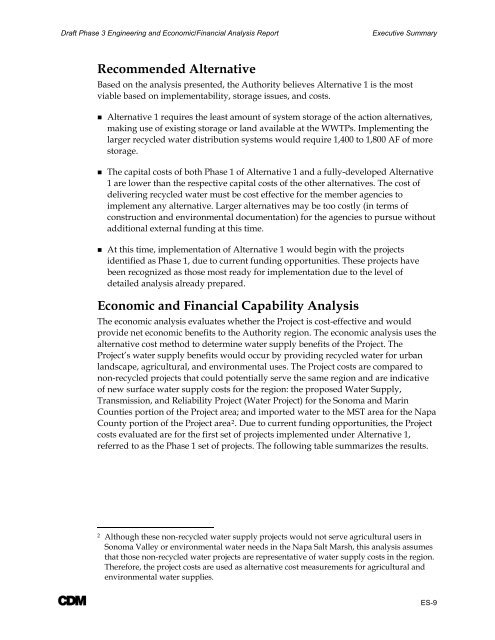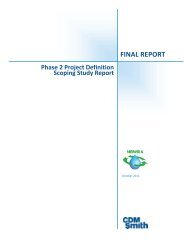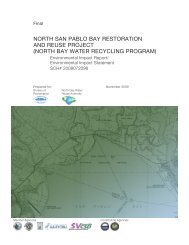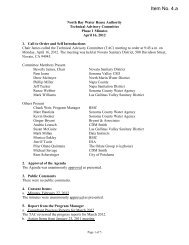Phase 3 Feasibility Report (Table of Contents & Executive Summary)
Phase 3 Feasibility Report (Table of Contents & Executive Summary)
Phase 3 Feasibility Report (Table of Contents & Executive Summary)
Create successful ePaper yourself
Turn your PDF publications into a flip-book with our unique Google optimized e-Paper software.
Draft <strong>Phase</strong> 3 Engineering and Economic/Financial Analysis <strong>Report</strong><br />
<strong>Executive</strong> <strong>Summary</strong><br />
Recommended Alternative<br />
Based on the analysis presented, the Authority believes Alternative 1 is the most<br />
viable based on implementability, storage issues, and costs.<br />
• Alternative 1 requires the least amount <strong>of</strong> system storage <strong>of</strong> the action alternatives,<br />
making use <strong>of</strong> existing storage or land available at the WWTPs. Implementing the<br />
larger recycled water distribution systems would require 1,400 to 1,800 AF <strong>of</strong> more<br />
storage.<br />
• The capital costs <strong>of</strong> both <strong>Phase</strong> 1 <strong>of</strong> Alternative 1 and a fully-developed Alternative<br />
1 are lower than the respective capital costs <strong>of</strong> the other alternatives. The cost <strong>of</strong><br />
delivering recycled water must be cost effective for the member agencies to<br />
implement any alternative. Larger alternatives may be too costly (in terms <strong>of</strong><br />
construction and environmental documentation) for the agencies to pursue without<br />
additional external funding at this time.<br />
• At this time, implementation <strong>of</strong> Alternative 1 would begin with the projects<br />
identified as <strong>Phase</strong> 1, due to current funding opportunities. These projects have<br />
been recognized as those most ready for implementation due to the level <strong>of</strong><br />
detailed analysis already prepared.<br />
Economic and Financial Capability Analysis<br />
The economic analysis evaluates whether the Project is cost-effective and would<br />
provide net economic benefits to the Authority region. The economic analysis uses the<br />
alternative cost method to determine water supply benefits <strong>of</strong> the Project. The<br />
Project’s water supply benefits would occur by providing recycled water for urban<br />
landscape, agricultural, and environmental uses. The Project costs are compared to<br />
non-recycled projects that could potentially serve the same region and are indicative<br />
<strong>of</strong> new surface water supply costs for the region: the proposed Water Supply,<br />
Transmission, and Reliability Project (Water Project) for the Sonoma and Marin<br />
Counties portion <strong>of</strong> the Project area; and imported water to the MST area for the Napa<br />
County portion <strong>of</strong> the Project area 2 . Due to current funding opportunities, the Project<br />
costs evaluated are for the first set <strong>of</strong> projects implemented under Alternative 1,<br />
referred to as the <strong>Phase</strong> 1 set <strong>of</strong> projects. The following table summarizes the results.<br />
2 Although these non-recycled water supply projects would not serve agricultural users in<br />
Sonoma Valley or environmental water needs in the Napa Salt Marsh, this analysis assumes<br />
that those non-recycled water projects are representative <strong>of</strong> water supply costs in the region.<br />
Therefore, the project costs are used as alternative cost measurements for agricultural and<br />
environmental water supplies.<br />
A<br />
ES-9








